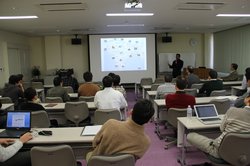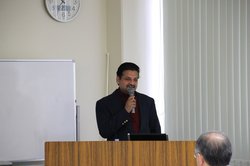Prof. Joby Joseph, Indian Institute of Technology Delhi Gave Special Lecture
20 Dec 2011
On December 20, Prof. Joby Joseph, Indian Institute of Technology Delhi was invited and gave a special lecture about "Phase Engineered Interference Lithography for Complex Photonic Structure Fabrication" and "High Density Holographic Data Storage and Search," at Venture Business Laboratory (EIIRIS-2).
About 27 researchers participated, and had a deep discussion with him after the lecture.


DATE & TIME
20 December, 2011
10:00-11:30
PLACE
VBL(EIIRIS-2) 3rd Floor
THEME
1. 'Phase Engineered Interference Lithography for Complex Photonic Structure Fabrication'
2. 'High Density Holographic Data Storage and Search'
SPEAKER
Prof. Joby JOSEPH
INDIAN INSTITUTE OF TECHNOLOGY DELHI
TOPICS
1. Optical interference and holography has long been a powerful tool in many areas of optics such as precision measurement, and information processing/storage etc.
Recently researchers have found a great potential in two and multiple beam interference techniques in forming 2-D and 3-D volumetric structures in photosensitive materials.
Even though, the fabrication of photonic structures on relevant length scales (i.e., nanometer, sub micrometer, and micrometer) can be achieved by means of various techniques such as electron or ion beam writing, deposition methods and self assembly, the prime advantage of interference lithography is, to fabricate large area defect-free nano-photonic structures both rapidly and cheaply.
The presentation gives an overview of the technique of holographic lithography for photonic structure fabrication, and describes a novel reconfigurable phase engineering based fabrication technique which is least complex and provide more flexibility compared to existing techniques at the same time this technique is capable of fabrication highly complex photonic structures.
2. A volume holographic data storage system (VHDS) employs holographic principles for the storage and retrieval of huge amounts of data at fast parallel transfer rates.
It provides high storage densities and fast data transfer rates with extremely short random access times.
A holographic storage disk can support a transfer rates in Gb per second in comparison to current technology's few Mb per second.
These features have been achieved by the page-oriented storage principle and the multiplexing of a large number of such data pages in a single location. In addition to conventional address-based read-out, VHDS offers the potential for simultaneous search of an entire database by performing multiple optical correlations between the stored data pages and a search argument.
Such an added feature of content-addressable searching is always beneficial considering its huge storage density.
Since a holographic search engine performs an entire database search with a single optical exposure, it can potentially search massive databases orders of magnitude faster than conventional alternatives.
Web page of EIIRIS:
http://www.eiiris.tut.ac.jp/index.html



